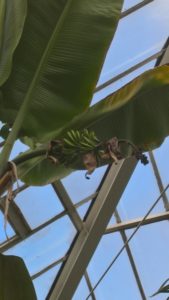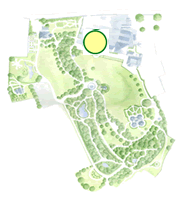Musa balbisiana
Plant of the month: September
 |
 |
Also known as: Plantain
Native to: South East Asia
Blooms: Spring to summer, fruits summer to autumn
Habitat: Margins of tropical rainforest
Where is it Found At BBG: Subtropical House
The genus Musa contain both bananas and plantains and are actually giant herbs, not trees, as they don’t have woody trunks. All Musa grow in warm, humid climates and are greedy plants needing fertile soils and lots of water.
Musa balbisiana is one of the wild ancestors of the cultivated plantain: a staple crop for millions of people throughout the tropics. Plantain fruits are usually cooked and eaten as a vegetable and contain high levels of minerals such as phosphorus, calcium and potassium as well as vitamins A and C. The fruits can be fried in oil, made into a ‘mash’ with butter, made into pancakes with a corn dough or boiled and served with honey. Plantains are not only sources of food; they provide shelter, building materials and fibre and are even used in rituals and religious ceremonies.
Its trunk can achieve many metres in height and its leaves are up to 2.7 metres long and 60 cm wide.
The flowers consist of an inflorescence which are a group of flowers. Male flowers are borne at the tip of the inflorescence and, beneath them, separated by several sterile flowers, are the female flowers which develop into the fruits. The fruits are arranged in hands, each formed of 10-20 bananas.

